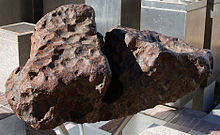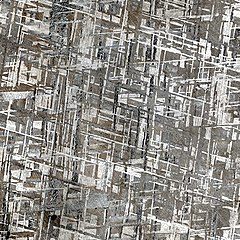astro.wikisort.org - Meteorite
Gibeon is a meteorite that fell in prehistoric times in Namibia. It was named after the nearest town: Gibeon.
| Gibeon | |
|---|---|
 Gibeon meteorites in Post Street Mall, Windhoek | |
| Type | Iron |
| Structural classification | Fine octahedrite |
| Group | IVA[1] |
| Composition | 91,8% Fe; 7,7% Ni; 0,5% Co; 0,04% P; 2,4 ppm Ir; 1,97 ppm Ga; 0,111 ppm Ge |
| Country | Namibia |
| Region | Great Namaqualand |
| Coordinates | 25°20′S 18°00′E |
| Observed fall | No |
| Fall date | prehistoric times |
| Found date | 1838[1] |
| TKW | 26000 kg[1] |
| Strewn field | Yes |
 Widmanstätten pattern | |
History
The meteorite was discovered by the Nama people and used by them to make tools and weapons.
In 1836[1] the English captain J. E. Alexander collected samples of the meteorite in the vicinity of the Fish River and sent them to London. There John Herschel analyzed them and confirmed for the first time the extraterrestrial nature of the material.
Between 1911 and 1913, 33 fragments of the meteorite were collected in the vicinity of Gibeon and brought to the capital Windhoek. They weighed between 195 and 506 kilograms (430 and 1,116 lb) and were first stored, then displayed at Zoo Park as a single heap. In 1975 a public fountain displaying the meteorite fragments was planned. The pieces were removed and stored at Alte Feste, where two of the fragments were stolen. The fountain was erected in Post Street Mall, with two empty pillars for the missing fragments. Since then, two more fragments were removed from the fountain, so that it displays only 29 today.[2]
The collection displayed on the fountain in Windhoek's Central Business District was proclaimed a National Monument (Category: geology) on 15 February 1950. Additionally, all meteorites found in Namibia are automatically protected as National Monuments and must not be removed from where they have been found, nor damaged in any way.[2]
Strewn field
The fragments of the meteorite in the strewn field are dispersed over an elliptical area 390 kilometres (240 mi) long and 120 kilometres (75 mi) wide. The core of this area is situated near the village of Gibeon in Namibia's Hardap Region. About 100–150 different fragments have been collected over time, and additional pieces are still[update] found occasionally.[2]
Composition and classification
The term Gibeon encompasses the whole meteoritic material fallen from the sky during this fall. This material is classified as iron meteorite belonging to the chemical group IVA.[1]
Gibeon meteorites are composed of an iron-nickel alloy containing significant amounts of cobalt and phosphorus. The crystal structure of this meteorite provides a classic example of fine octahedrite and the Widmanstätten pattern is appreciated for its beauty both by collectors and designers of jewelry.
See also
- Glossary of meteoritics
References
- Meteoritical Bulletin Database: Gibeon
- Voigt, Andreas (2004). National Monuments in Namibia: An Inventory of Proclaimed National Monuments in the Republic of Namibia. Gamsberg Macmillan. pp. 1–3. ISBN 9991605932.
External links
| Wikimedia Commons has media related to Gibeon. |
На других языках
[de] Gibeon (Meteorit)
Der Gibeon-Meteorit (englisch Gibeon Meteorite; in der Fachliteratur auch teilweise nur als Gibeon bezeichnet) ist ein Eisenmeteorit, dessen Bruchstücke erstmals 1836 in Südwestafrika, nahe der Stadt Gibeon am Ostufer des Großen Fischflusses gefunden wurden. Die Fundkoordinaten liegen bei 25° 30’ südl. Breite und 18° 00’ östl. Länge.[1] Er wurde zuerst von Capt. James Edward Alexander beschrieben. Der kaiserliche Geologe Paul Range berichtete 1913 von einzelnen Massen, die in situ auf den im Gebiet vorkommenden, pleistozänen Kalahari-Kalken aufliegend entdeckt wurden. Range schloss daraus, dass der Meteorit erst nach Bildung dieser Formationen gefallen sein konnte.[2] Datierungen dieser Schichten ergeben ein Alter von 13.000 bis 30.000 Jahren.[3] Das Entstehungsalter des Meteoriten selbst wird mit über vier Milliarden Jahren angegeben.- [en] Gibeon (meteorite)
[ru] Гибеон (метеорит)
Метеорит Гибеон (англ. Gibeon) — железный метеорит найденный на юге Африки в 1836 году.Другой контент может иметь иную лицензию. Перед использованием материалов сайта WikiSort.org внимательно изучите правила лицензирования конкретных элементов наполнения сайта.
WikiSort.org - проект по пересортировке и дополнению контента Википедии

